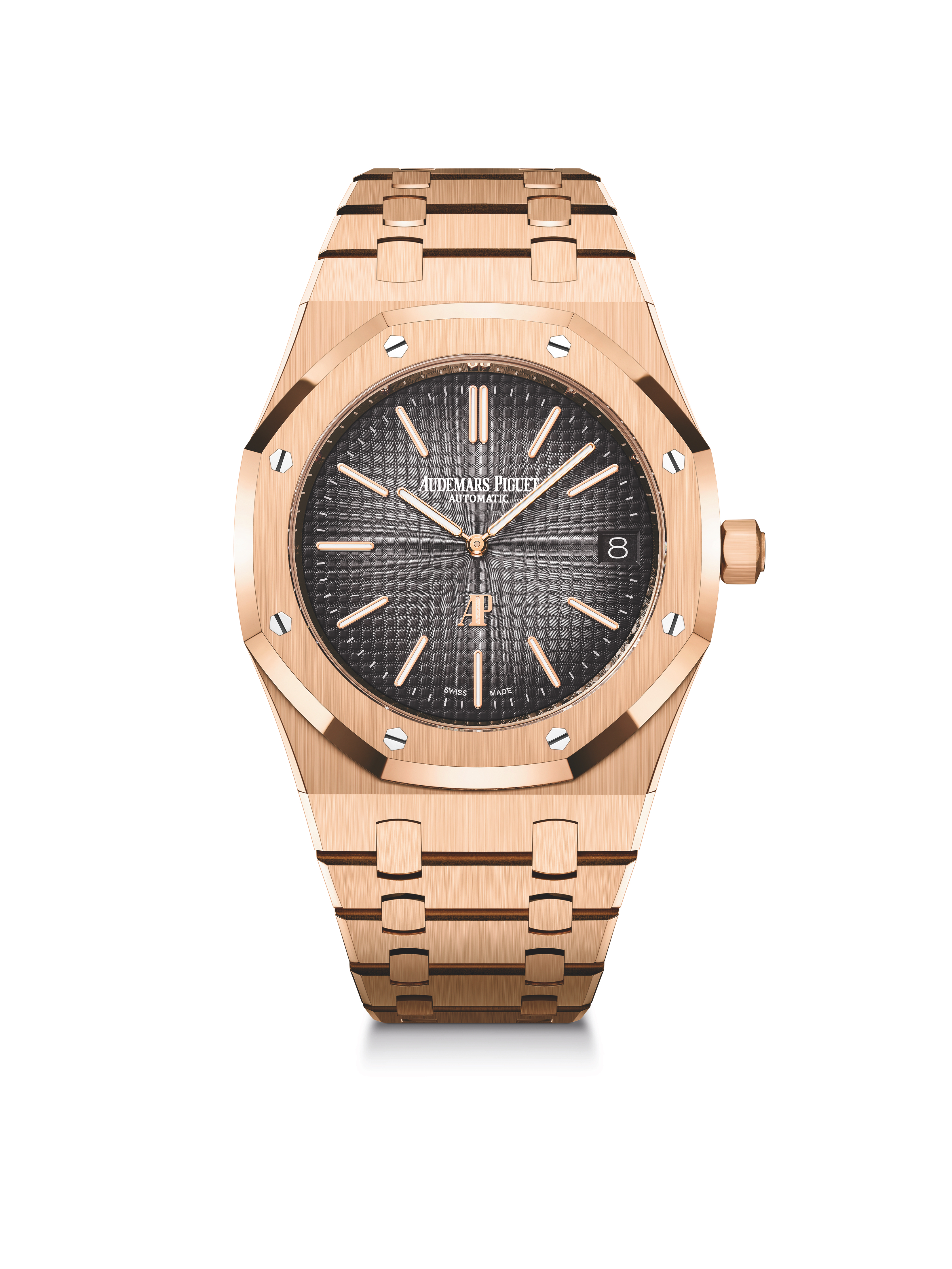Audemars Piguet’s Royal Oak at 50
2022 marked 50 years since the launch of Audemars Piguet’s Royal Oak. Wallpaper* acting editor-in-chief Bill Prince reflects on the craft and history of a classic timekeeper

The launch of the Royal Oak 50 years ago represents one of the last truly transformative moments in modern mechanical watchmaking.
Why? Because the advent of Audemars Piguet’s most lauded model in 1972 marked a sea change in the relationship between a watch and its wearer: from a time when quality was generally represented by a discreet-looking timepiece in a precious metal, to the era we live in today, in which a watch serves as the perfect lifestyle accessory.
The Royal Oak at 50
From a simple, time-only with-date model – the original 5402ST – the Royal Oak redrew the horological map, setting the course not only for a revolution in the watch industry, but the entire market for luxury goods. It also placed Audemars Piguet’s home in the small village of Le Brassus, in Switzerland’s Vallée de Joux, which has served as a centre of complicated watchmaking since the 18th century, at the heart of a new era of haute horology, even as the brisk winds of the so-called Quartz Crisis swirled.
The Royal Oak did so thanks to a one-of-a-kind, out-of-the-box design, famously drawn in a single night in April 1970 by the ‘Picasso of Watchmaking’, Gérald Genta. He was doubtless spurred on by the same restless spirit of innovation that had led Audemars Piguet to develop the world’s thinnest automatic movement, Calibre 2120, years earlier, the date version of which would debut in the original first Royal Oak ‘Jumbo’.
Trying to nail the innate and imbued qualities of Genta’s design in a sentence is like trying to catch flames in a fishing net. However, one inalienable quality sets it apart from most other watches on the market then and now – a magical presence on the wrist. But this barely touches the sides of the Royal Oak’s manifest, objective appeal. For that, you need to plunge deeper – deeper even than the old-time diving helmet, or scaphander, that legendarily inspired the watch’s octagonal bezel.
To understand the unique qualities of the watch requires an appreciation of classical proportions and of the power of sacred geometry – Genta was a scholar of Renaissance architecture and, in particular, ecclesiastical design – as well as of the stylistic principles underpinning art deco, reflected in the materiality of its unique bracelet assembly (at the time the most complex ever attempted).

A diver in 1933 wearing a scaphander diving helmet, which inspired Gérald Genta to design the Royal Oak watch
The fact that it harnessed the most valued attributes of the past – the traditions of the Vallée de Joux – in the most radical manner possible was clearly no bad thing. But it’s also important to recognise the sheer bravado of parading the supposed ‘innards’ of a watch – within its case the bold display of eight hexagonal screw heads puncturing the bezel. Together, these elements have conspired to create a watch with the uncanny ability to match the prevailing ethos of each of the decades through which it has passed.
Receive our daily digest of inspiration, escapism and design stories from around the world direct to your inbox.
Decades of style and innovation
Clearly, when the Royal Oak was being developed, the world itself was changing. The opulence and ostentation associated with old money was being replaced by a new, more egalitarian approach to success and, therefore in particular, the signifiers of wealth. An example of this can be seen in fashion. When Yves Saint Laurent introduced the world’s first ready-to-wear fashion couture line, Rive Gauche, he championed luxed-up versions of what might previously have been dubbed ‘work wear’ – the famous unisex trench coat, for example, and that staple of 1970s menswear style, the ‘safari’ jacket (itself an early code name for the watch later crowned the Royal Oak).
As Western culture embraced this ‘youth-quake’, Genta’s design met the need for a highly refined timepiece that carried forward the period’s fascination with emblems of energy and emancipation. The 1970s, in the West at least, was marked by shifting geopolitical sands and a major recession brought on by the 1973 Oil Crisis – a time during which, it could be argued, a beautifully executed stainless steel watch served as the original 'stealth wealth’ option. At the same time, a new leisure class emerged, international, inclusive – up to a point – and eager to embrace the Royal Oak’s invocation of a good life well lived.
Indeed, one of its earliest adopters was one of the most important designers of the age, Karl Lagerfeld, quickly followed by a host of what we would today call influencers, but at the time were simply referred to as ‘cool’.

Gérald Genta in 1990
The 1980s ushered in a new era of affluence, often achieved at a much younger age than for earlier generations, thanks to financial deregulation and the trickle-down economics adopted in large Western economies.
The growing Royal Oak collection responded with bold dials and precious metals, all designed by a woman whose role in the story of this timepiece can never be overstated: Jacqueline Dimier.
The 1980s also saw the introduction of complications into the Royal Oak collection, first a calendar model in 1983, followed a year later by the landmark Model 5554, which featured the world’s slimmest self-winding perpetual calendar – the epochal Calibre 2020/2800.
For many, the arrival of Model 5554 represents the consecration of a new era in mechanical watchmaking, one in which emblematic complications, including the perpetual calendar, were freed from the round watch/precious metal conformity of the past.
The Royal Oak can thus justly claim to have led the field in this regard. Having jumped the guardrails of conventional watch design 50 years ago, today the Royal Oak collection continues to serve as an ambassador for the latest developments in ultra-high-end watchmaking, not least the work of Audemars Piguet Le Locle, the developmental arm of Audemars Piguet set up by Dominique Renaud and Giulio Papi.
Heralded by the Royal Oak Concept in 2002, this remarkable new generation of movements developed by Audemars Piguet’s master watchmakers – including the breathtaking RD#2 ultra-thin Perpetual Calendar unveiled in 2019 – has now been joined by Calibre 7172, the replacement for the hallowed Calibre 2121, the world’s thinnest automatic movement with date function when it debuted in the original Royal Oak ‘Jumbo’ in 1972.

The Royal Oak model 5402, from the Audemars Piguet Heritage collection. Made from steel and housing a selfwinding Calibre 2121
Hyperbole rarely survives scrutiny, but it’s fair to say that the Royal Oak is both an outlier and a unicorn – a watch that continues to disrupt the conventions of mechanical watchmaking whilst serving as a timepiece that ranks as one of the most desirable on earth.
Recently, I asked Audemars Piguet’s global CEO, Francois-Henry Bennahmias, why we are still talking about the Royal Oak 50 years after its launch. His reply was characteristically straightforward and on-the-money: ‘Why are we still talking today about Neil Armstrong? About Leonardo Da Vinci? Why are we talking about Elvis Presley or Mozart or Beethoven? They wrote history. That’s why.’
Here are five more reasons why I believe the Royal Oak is still talked about today.
5 reasons Audemars Piguet Royal Oak endures
1. Its singularity
The Royal Oak was born as one model, produced for a scant six years in a single case material and size – Model 5402ST or ‘Jumbo’. Over the years it has been joined by over 850 different models in numerous sizes and styles, to which have been added a vast array of complications, from chronographs to perpetual calendars to Grande Complications. But at its core remains the essential trinity of the 5402’s defining characteristics: its bezel, hexagonal screws and, in most instances, the fully integrated bracelet.
2. The symmetry of its design
There is no denying the watch’s unifying presence on the wrist – one of the most harmonious watch designs of all time, unfettered by unnecessary ornamentation yet highly decorative in its own, rarefied, way.
3. Its tactility
A wine connoisseur might recognise it as ‘mouth feel’; here, it refers to the way in which the watch’s finely honed angles and the mellifluous articulation of the articulating bracelet offer a dexterous embrace never before found in such a resolutely robust timepiece.

The Royal Oak 'Jumbo' Extra-Thin '50th Anniversary' watch in pink gold
4. A coherence across the entire collection
The watch’s lineage now extends to as many as 24,000 individual styles. Factor in the Royal Oak Offshore (which celebrates its own anniversary in 2023) and Concept watch pieces, and it’s clear the Royal Oak retains an uncompromising fealty to Genta’s original design – an extraordinary achievement given the sheer number of complications, materials and decorative executions it has embraced.
5. The cadence of its evolution
If the rhythms of a life can be discerned, they can be seen clearly in the manner in which the Royal Oak collection has developed – growing from a solitary model to become an extended family of complicated, and ever more complex, timepieces. A process, moreover, that has kept pace with an ever-changing world without ever demoting its forebears in the process.
Evidence of this can clearly be seen in the current appreciation of earliest Royal Oak models, and the unprecedented demand for the 50th anniversary collection launched earlier this year.
Further reading: Royal Oak: From Iconoclast To Icon, published by Assouline (2022).

The Royal Oak 'Jumbo' Extra-Thin '50th Anniversary' watch in yellow gold
Bill Prince is a journalist, author, and editor-in-chief of Wallpaper* and The Blend. Prior to taking up these roles, he served for 23 years as the deputy editor of British GQ. In addition to editing, writing and brand curation, Bill is an acknowledged authority on travel, hospitality and men's style. He is the author of two books, Royal Oak: From Iconoclast To Icon – a tribute to the Audemars Piguet watch at 50 – and The Connaught, a history of the legendary Mayfair hotel, both published by Assouline
-
 Year in review: the shape of mobility to come in our list of the top 10 concept cars of 2025
Year in review: the shape of mobility to come in our list of the top 10 concept cars of 2025Concept cars remain hugely popular ways to stoke interest in innovation and future forms. Here are our ten best conceptual visions from 2025
-
 These Guadalajara architects mix modernism with traditional local materials and craft
These Guadalajara architects mix modernism with traditional local materials and craftGuadalajara architects Laura Barba and Luis Aurelio of Barbapiña Arquitectos design drawing on the past to imagine the future
-
 Robert Therrien's largest-ever museum show in Los Angeles is enduringly appealing
Robert Therrien's largest-ever museum show in Los Angeles is enduringly appealing'This is a Story' at The Broad unites 120 of Robert Therrien's sculptures, paintings and works on paper